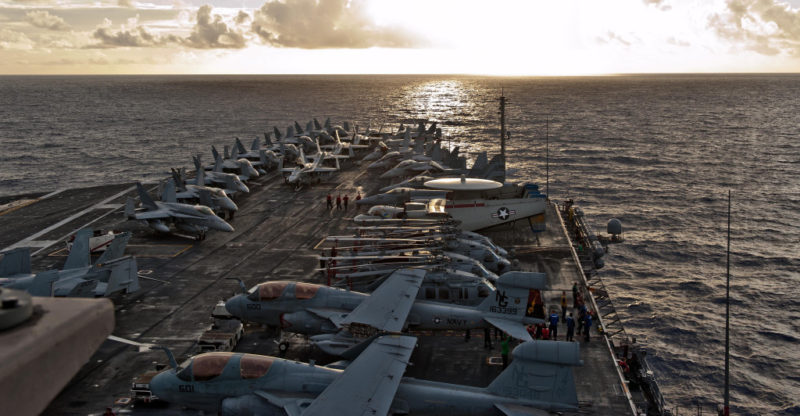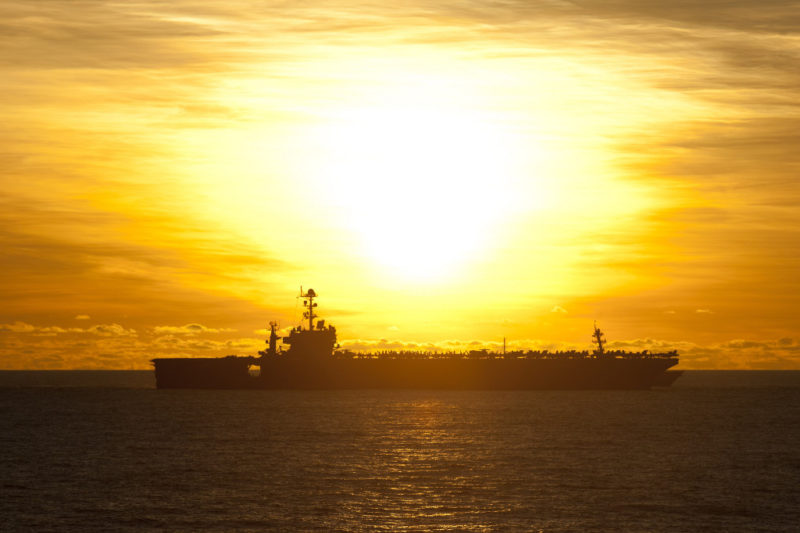The U.S. Navy’s 7th Fleet and 3rd Fleet To Be Combined?
The United States Navy is considering combining two of its most powerful fleets to counter China. What is the most powerful navy in the world? Some say it is the U.S. Navy, but to be more specific, the U.S. Navy’s 7th Fleet.
The United States is currently transferring equipment and personnel to the western Pacific as part of the Obama administration’s “Pacific Pivot.” 60% of the USN’s assets are being shifted to forward deployed locations in the Pacific theater to counter China as it rapidly transforms its near to shore navy into a blue water capable navy, that is until Russia recently became provocative and aggressive towards the west, implying the USN will have to consider fending off both the Russians and the Chinese in a potential conflict at sea. While the 7th Fleet certainly has the potential capability of tackling both adversaries, it’s not the guarantee the admirals are looking for.
The 7th Fleet is assigned to the western portion of the Pacific that also encompasses the highly contested South China Sea. The 7th Fleet has more per square miles of responsibility to cover than any of the other six fleets, which explains why it has the only forward deployed aircraft carrier, the U.S.S. Ronald Reagan, 80 ships, 500 aircraft, and 50,000 Navy and Marine Corps personnel assigned to it. It is now likely to expand even more.
 Image Credits: U.S. Pacific Fleet. Creative Commons License. USS John C. Stennis when in the Pacific Ocean.
Image Credits: U.S. Pacific Fleet. Creative Commons License. USS John C. Stennis when in the Pacific Ocean.
While it’s not uncommon to have the 3rd Fleet, whose responsibilities lay along the United States and Canada’s west coasts, transfer its assets to the 7th when they enter the 7th’s area operation(AO), the entire Western Pacific, it would be unprecedented to scrap the boundary separating the two fleets completely. A U.S. Pacific Fleet naval official told Reuters,
“The idea is to scrap the administrative boundary but that is at the conceptual stage. The plan revolves around the Third Fleet operating forward. It would formalize and expand the Third Fleet’s role in the Western Pacific from a command and control perspective.”
The official chose to remain anonymous as he was not authorized to speak to the media, but on occasion high ranking military officials let slip information as a form of psychological warfare or manipulation. It is hoped the news that the introduction of four additional U.S. carriers and their assigned battlegroups, USS Nimitz, USS Carl Vinson, USS Ronald Reagan, the USS John C. Stennis, into the Western Pacific would weaken Russia and China’s geo -political will and deter conflict.
 Image Credits: U.S. Navy. Creative Commons License. USS George Washington conducts replenishment at sea. and when underway in the U.S. 7th Fleet area of responsibility.
Image Credits: U.S. Navy. Creative Commons License. USS George Washington conducts replenishment at sea. and when underway in the U.S. 7th Fleet area of responsibility.
The USN has signaled that it’s combining the two fleets, but it has gone fairly unnoticed. U.S. Pacific Fleet Commander Admiral Scott Swift said in a speech at 7th Fleet Headquarters in Yokosuka, Japan, that he did not see a reason to have the two fleets separated anymore. He added that Vice Admiral Nora Tyson of the 3rd Fleet would represent the USN at Japan’s triannual Fleet Review in October, rather than the 7th Fleet’s Vice Admiral Joseph Aucoin.
“I would not be surprised to see more of Vice Admiral Tyson operating forward as part of this concept development process.”
The two fleets would likely not change headquarters, but would operate as one, seamlessly moving game changing assets around the Pacific with ease. Thus this does answer the question, Will the “U.S. Navy’s 7th Fleet and 3rd Fleet to be combined”?
With the two fleets combined, it would force the Chinese and the Russians to reevaluate their plans to project power in the Pacific. In September 2015, the Chinese Navy, also known as the P.L.A.N., were detected off the Alaskan coast for the first time, coinciding with President Barack Obama’s first trip to the state. The Chinese delivered the message that they can now put assets off our coast, just like the U.S. routinely does off of their coast. Combining the 3rd and 7th Fleets would give the Chinese a hell of a lot more to deal with on their home front, forcing them to use more of their naval assets to track USN activities. Monitoring the 3rd and 7th Fleets would curb Chinese land reclamation and assertive territorial claims with U.S. allies. The balance of power would remain with the U.S.
All the images follow the Creative Commons License, free to use for Commercial purposes. Thus are free to be commercially distributed, can be redistributed in any medium and can also be modified, as long as proper credits are given (Which Has Been) and if changes are made is mentioned.









it’s gonna be fun.